Table of Contents
Amphibious Excavator, AKA swamp buggy, is more and more well known by people. But if you are in the dredging industry, then the cutter suction dredger, AKA suction dredger, is more familiar to you. Huge cutter-suction boats drive on wide rivers and even seas, and the cutter-suction pumps continuously pump the silt from the bottom of the water to the shore. With the acceleration of urbanization, dredging projects are gradually carried out in cities. Many urban rivers also require dredging. At this time, the huge cutter suction dredger seemed a bit overkill. The good news is that the development of amphibious excavators fills this gap. In some small dredging projects, the importance of amphibious excavators is constantly highlighted.
Today, with the development of amphibious excavators in full swing, many engineering contractors want to use amphibious excavators instead of cutter suction dredgers for medium-sized or even large-scale construction. After all, amphibious excavators have an absolute price advantage over cutter suction dredgers. But can amphibious excavators really replace cutter suction dredgers? What are the advantages and disadvantages of each?
Advantages and Disadvantages of Cutter suction dredgers
Advantages of cutter suction dredger
Since it is called a cutter suction dredger, it is presented in the form of a boat. That is to say, no matter how small the cutter suction dredger is, it is also a huge monster for general machinery. This also means that the cutter suction dredger has sufficient stability. No matter in the river or even at sea, it has a very strong anti-risk ability.
Some cutter suction dredgers also have a storage function, which can temporarily store the suctioned sediment on board. Wait for the cutter suction dredger to dock before unloading. In some projects far from the shore, this function is particularly important.
In addition, due to its powerful horsepower, the efficiency of the sediment that the cutter suction dredger can handle is very high. In large-scale construction projects, the efficiency of the cutter suction dredger is obvious to all.
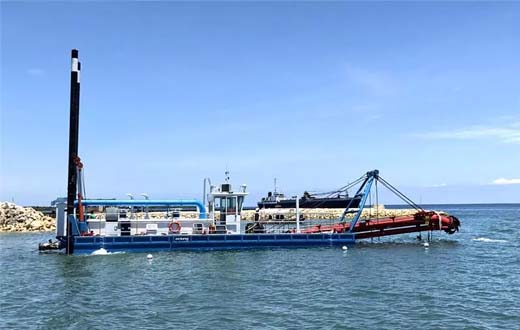
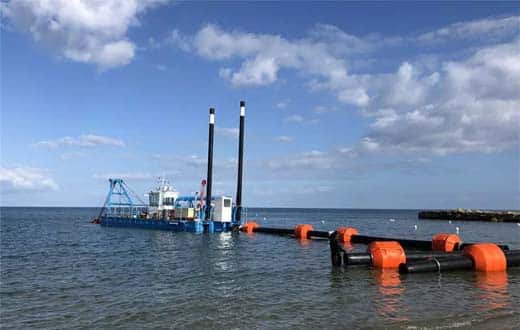
Disadvantages of cutter suction dredgers
The cutter suction dredger has a large volume and good stability, but relatively, the flexibility is insufficient. It cannot be used in some small waters. In many terrains where the water depth is insufficient, the cutter suction dredger cannot be launched.
After all, the cutter suction dredger is a machine for water operations. If the project needs to be converted into different terrains, such as when it needs to cross from one water area to another, the cutter suction dredger cannot complete the task. After all, a cutter suction dredger cannot travel on land by itself. If transshipment is required, it will cost a lot to complete.
The cutter suction dredger is manufactured in one piece, and the whole cutter suction dredger needs to be purchased, which is very expensive. For the average small project company, this is an unaffordable expense. In some medium-sized projects, it is also necessary to consider the input-output ratio to determine whether to purchase a cutter suction dredger.
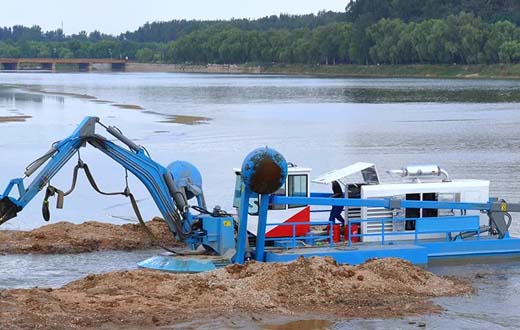
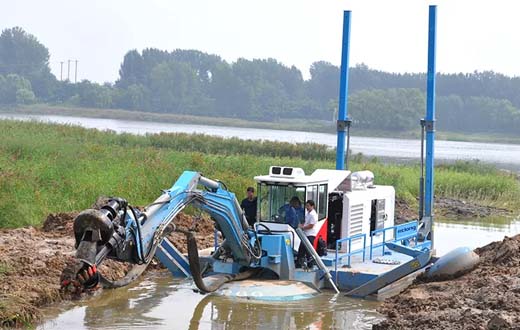
Amphibious Excavator: A Versatile Machine for Land and Water
Advantages of amphibious excavators
The biggest advantage of the amphibious excavator is that it can walk on land while also being able to work on water. The feature of adapting to multi-terrain makes it a popular amphibious equipment for water engineering projects in recent years.
The smallest model of an amphibious excavator can reach 5 tons. Such amphibious excavators can be adapted to very small engineering projects. Even ponds in your own backyard can be used. This makes the application field of amphibious excavators wider.
The amphibious excavator can also be retrofitted with an existing standard crawler. Amphibious undercarriages replace the existing undercarriage to make it more buoyant in shallow waters, aiding mobility. This saves a lot of money. It can also be undertaken by small engineering companies with insufficient funds. Choosing different undercarriages according to different engineering projects makes the company’s operation more flexible.
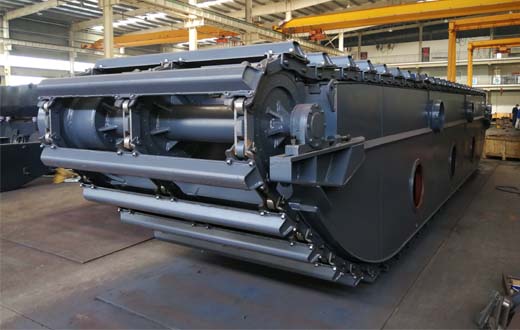
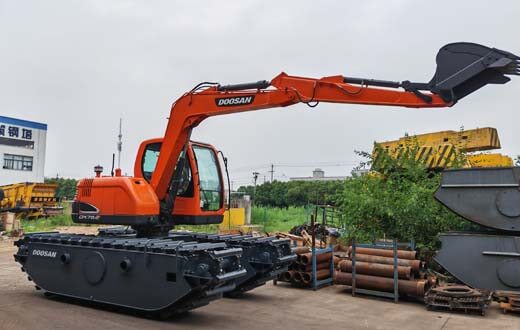
Disadvantages of amphibious excavators
Although amphibious excavators can operate on land and in rivers, operating amphibious excavators in water is also dangerous. Only after confirming that the type of pontoons belongs to the full floating excavator type can it work in deep water. And only experienced drivers can flexibly master the essentials of operation.
Although the amphibious excavator can walk on land, in the water, the amphibious excavator can only move by supporting the bottom of the water to generate power. Although hydraulic propellers can be added to amphibious excavators to provide power, this also increases a lot of costs.
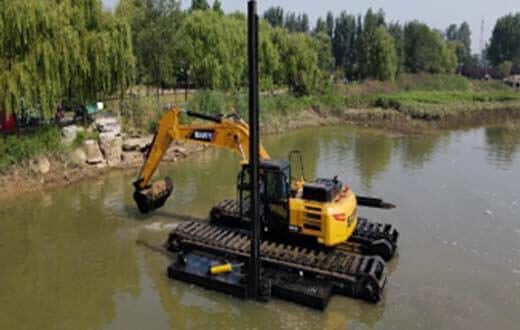
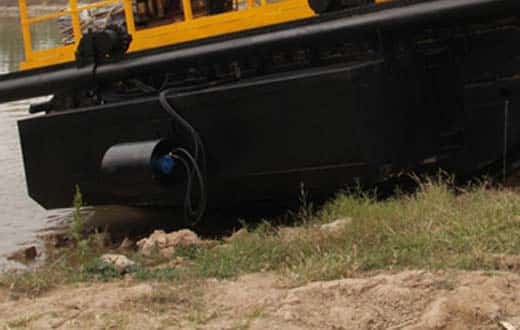
Limitations common to dredgers and amphibious excavators
Applicable water depth
Although the cutter suction dredger is larger and safer, the water depth it can operate in is not large. Mainly due to the limited length of the boom on board. In sand pumping and dredging operations, the water depth is only about 10 meters.
In addition to the length of the boom, safety is also one of the main reasons for restricting the water depth of the amphibious excavator. After all, the danger will be greatly increased in the operation area with a water depth of more than 10 meters. We generally do not recommend amphibious excavators to operate in water depths greater than 8 meters.
Water surface conditions
Even if a cutter suction dredger can operate in larger open waters, safety cannot be guaranteed if the waves on the water’s surface are too large. For construction, a stable water surface condition is a prerequisite to ensure construction efficiency. Therefore, when working in the sea, factors such as weather and water surface should be considered to avoid safety accidents.
Amphibious excavators have more stringent requirements for water surface conditions. After all, the area of the amphibious undercarriage is not as large as that of the cutter suction dredger. Although it is safe on calm water, once a storm hits, there is no way for amphibious excavators to avoid risks. Therefore, we do not recommend operating on stormy water.
Which one should I choose between the cutter suction dredger and the amphibious excavator?
Now that we know the advantages and disadvantages of cutter suction dredgers and amphibious excavators, which one should we choose between cutter suction dredgers and amphibious excavators?
We can choose through our judgment on different working environments.
Swamps environment
For construction projects in swamp environments, there is nothing to say but amphibious excavators. After all, cutter suction dredgers cannot drive and work in swamp environments. In the swamp, the advantages of amphibious excavators are most obvious.
Rivers and ditches
In this case, it is necessary to judge the water depth and width of the river or ditch in the specific project. Because the cutter suction dredger has a large volume, it is not suitable for narrower rivers or shallow water. For creeks that are only 5 meters wide, cutter suction dredgers are powerless. Even if you choose an amphibious excavator, you can only choose a small model.
In addition, if the flow rate of the river is fast, the amphibious excavator may not be suitable. After all, the stability of the cutter suction dredger is greater than that of the amphibious excavator. In the absence of wind and waves, even if the water velocity is fast, it will not affect the operation of the cutter suction dredger.
Open water
In open waters, such as large rivers and seaside, cutter suction dredgers may have more advantages. But some rivers also have branches that are inaccessible to dredgers. Or when working on the seashore, some places closer to the shore can not be approached by the cutter suction dredger. That’s when amphibious excavators take over.
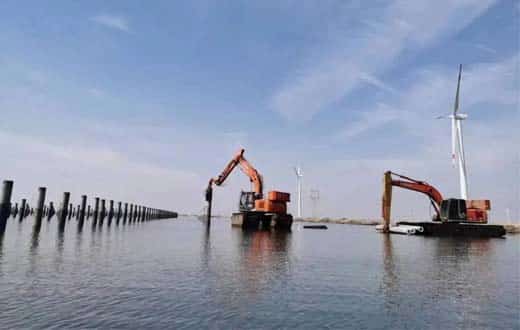

We can also judge the choice by engineering project requirements.
The overlapping engineering projects applicable to cutter suction dredgers and amphibious excavators are still very high. For example, both machines can undertake dredging jobs, and can also undertake river bottom sand pumping jobs. But specific to a certain project, the demand for the machine may be different. For example, a project may require a certain level of output per hour. At this time, high-horsepower equipment is needed to ensure production. Cutter suction dredgers can carry more engines. At this time, the cutter suction dredger should be a better choice. But if the engineering project requires simultaneous operation in different places. Taking into account economic issues, it may be more cost-effective to use two amphibious excavators.
A new product, the amphibious dredger, may solve all of the above problems. Let us wait and see.
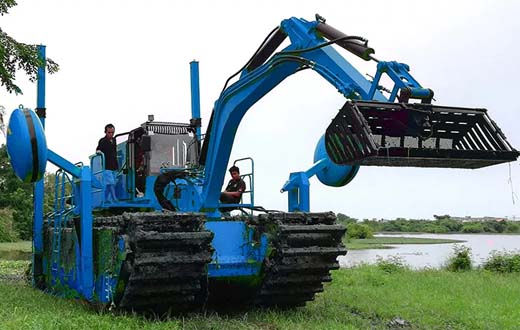
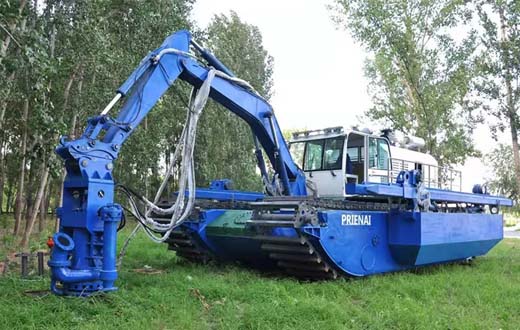
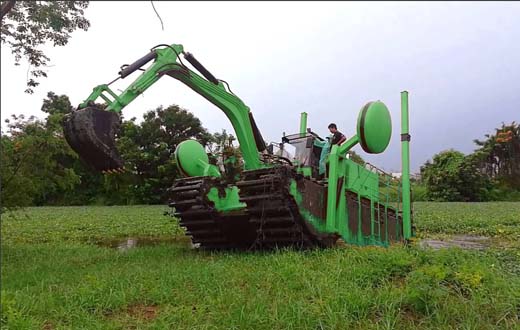
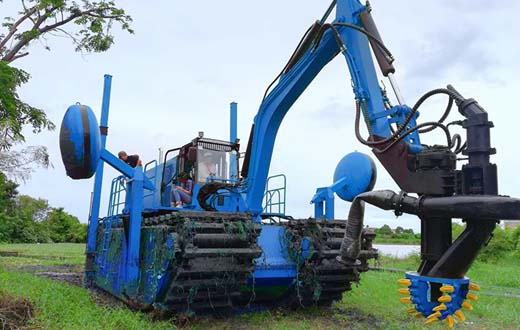
Summarize:
Above we have listed the advantages and disadvantages of cutter suction dredgers and amphibious excavators, and pointed out the limitations faced by both machines. It also gives some of our suggestions and opinions on how to choose a cutter suction dredger and an amphibious excavator.
The final judgment still needs to be drawn from the analysis of the actual situation. That’s why we recommend full communication with manufacturers before purchasing cutter suction dredgers and amphibious excavators. It is best to clearly introduce the working conditions that need to be faced, as well as the plans for the future. Such an experienced manufacturer will customize the design according to the needs of customers, provide a quality solution that meets this project and can continue to contribute in the future.
